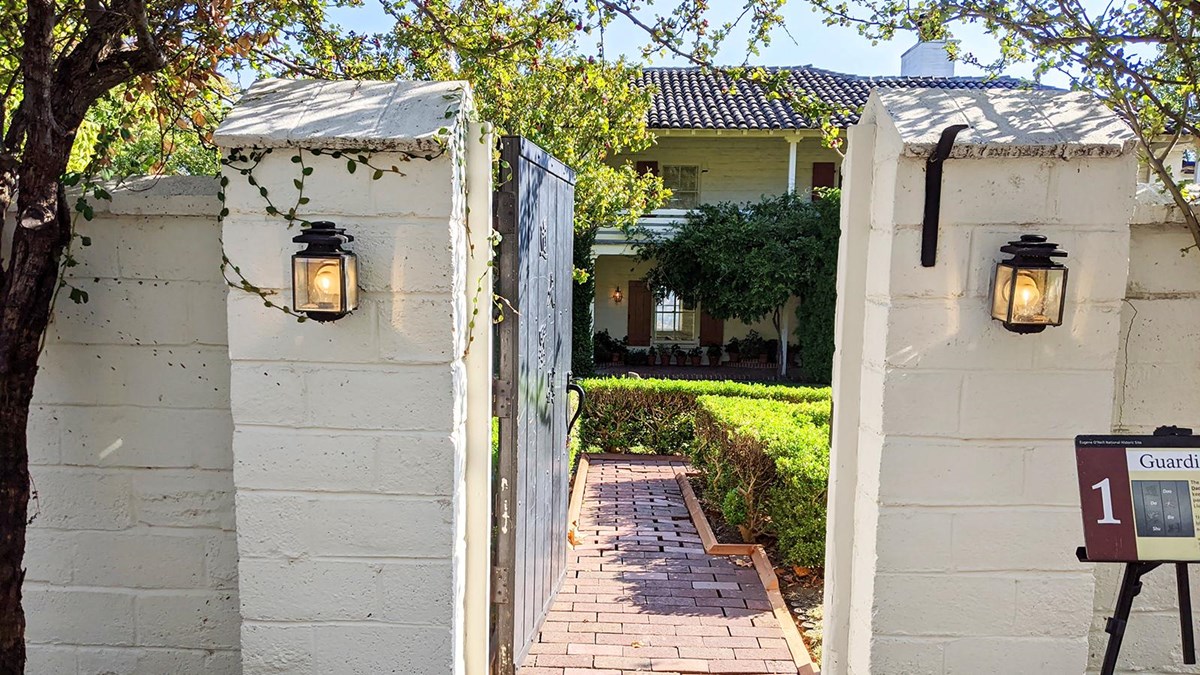Part of a series of articles titled Women's History in the Pacific West - California-Great Basin Collection.
Previous: Laura Perrott Mahan
Next: LaNada War Jack
Article

Library of Congress, Prints & Photographs Division, Carl Van Vechten Collection, [LC 2004663424]
Article by: Faith Bennett
Once an actress with abandoned dreams of joining a convent, Carlotta Monterey O’Neill collaborated with her playwright husband Eugene O’Neill on some of his most famous work during their five years in “Tao House” in Danville, California. She was born Hazel Nielson Taasinge in San Francisco in 1888 to Christian Nielson Taasinge and Nellie Taasinge. When her parents divorced, she was sent to St. Gertrude’s Academy of the Convent in Rio Vista, California. At sixteen she contemplated taking religious vows herself, but instead went to study theater in England, where she married and divorced her first husband, John Moffat.i Changing her name to the dramatically Californian “Carlotta Monterey,” she pursued a stage career and travelled frequently, marrying her second husband, Melvin Chapman Jr. and giving birth to their daughter, Cynthia, whom she left in the care of her mother after her divorce from Chapman.ii
In 1922, Monterey was cast in a role that would change her life: the female lead Mildred Douglas in Eugene O’Neill’s The Hairy Ape. Portraying a wealthy “new woman” who hopes to pursue the profession of social work, Monterey delivered the infamous line that the laboring protagonist was a “filthy beast,” spurring him to revenge. During this production, she met her third husband, Ralph Barton, and the playwright O’Neill, whom she initially regarded as “the rudest man I’d ever seen.”iii Barton and Monterey divorced in 1926 and two years later, O’Neill premiered his play Strange Interlude with a character, Nina, inspired by Monterey. The couple eloped in 1928. They initially planned to honeymoon in Europe but extended the trip through 1929 to include East Asia. The pair hoped to indulge their fascinations with Eastern Philosophy that had been stoked by such theosophical texts as British author Mabel Collins’ Light on the Path. However, their long stay in Shanghai was defined primarily by the hotel room, as the playwright worried that any public appearances would result in unwanted media attention.iv
When they decided in 1937 to put down roots in California, it was Monterey who sought out the property and designed Tao House. In constructing and decorating, they employed an Orientalist aesthetic that many middle-class and elite white Americans embraced as a marker of cosmopolitanism in the early twentieth century. Those same choices exoticized and repurposed Asian culture.v Describing the approach to the design, Monterey wrote, “I wanted to build a Chinese house, but I didn’t have the money so I built a sort of pseudo-Chinese house.”vi  Tao House, with its terra cotta roof, dark blue ceilings and green mirror, combined Monterey’s appreciation of the Spanish colonial influences she grew up admiring and the Chinese motifs she loved as an adult. She bought almost all the furnishings, including what she called her “big Chinese bed” from the San Francisco antique dealer Gump’s.vii Her friend, Chinese-American writer and painter Mai-Mai Sze noted “the O’Neills had a naïve, romantic idea of China-- the wisdom, pageantry, and so forth were superficially conceived and romanticized by them.”viii
Tao House, with its terra cotta roof, dark blue ceilings and green mirror, combined Monterey’s appreciation of the Spanish colonial influences she grew up admiring and the Chinese motifs she loved as an adult. She bought almost all the furnishings, including what she called her “big Chinese bed” from the San Francisco antique dealer Gump’s.vii Her friend, Chinese-American writer and painter Mai-Mai Sze noted “the O’Neills had a naïve, romantic idea of China-- the wisdom, pageantry, and so forth were superficially conceived and romanticized by them.”viii
Monterey and O’Neill spent a total of five years in Tao House. In those years, O’Neill wrote many of his most highly regarded works including Mourning Becomes Electra, which he referred to as “Carlotta’s play,” The Iceman Cometh, and Long Day’s Journey Into Night. He wrote by hand; she deciphered, typed, and conducted the business side of his work. On their twelfth wedding anniversary O’Neill gave her the original script of Long Day’s Journey Into Night.ix Due to their increasing health problems, they left Tao House in 1944. In 1956, three years after her husband passed away, Monterey released the play. The choice was against his wish that it not be published until twenty-five years following his death, yet it helped secure his legacy in American theater. Monterey died in 1970.
This project was made possible in part by a grant from the National Park Foundation.
This project was conducted in Partnership with the University of California Davis History Department through the Californian Cooperative Ecosystem Studies Unit, CA# P20AC00946
Part of a series of articles titled Women's History in the Pacific West - California-Great Basin Collection.
Previous: Laura Perrott Mahan
Next: LaNada War Jack
Last updated: November 18, 2024